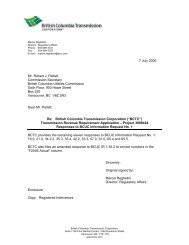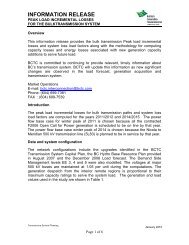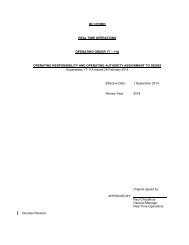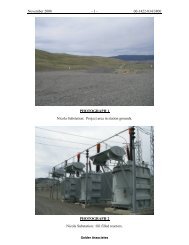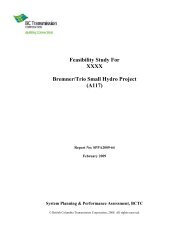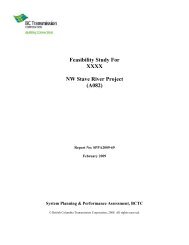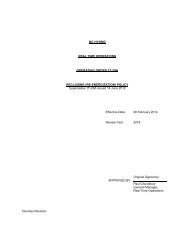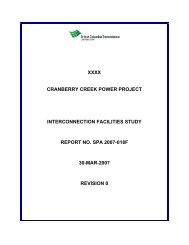Evidence on the Adequacy of First Nations Consultation - BC Hydro ...
Evidence on the Adequacy of First Nations Consultation - BC Hydro ...
Evidence on the Adequacy of First Nations Consultation - BC Hydro ...
You also want an ePaper? Increase the reach of your titles
YUMPU automatically turns print PDFs into web optimized ePapers that Google loves.
Kinbaskit, <strong>the</strong> Chief, who is nearly always encamped about <strong>the</strong> head waters <strong>of</strong> <strong>the</strong> Columbia has made a<br />
horse trail from <strong>the</strong> mouth <strong>of</strong> Toby Creek, which c<strong>on</strong>tinues al<strong>on</strong>g its bottom for 2 days journey, <strong>the</strong>n he<br />
follows a foot trail which passes over <strong>the</strong> summit traversed by Mr. Howman and reaches <strong>the</strong> Kootenay<br />
Lakes in 2 days more, thus taking 4 days to complete <strong>the</strong> journey.<br />
But as referenced by Affleck, 48 <strong>the</strong> Lower Ktunaxan guides <strong>of</strong> James Turnbull, who was Moberly’s<br />
colleague <strong>on</strong> <strong>the</strong> expediti<strong>on</strong>, could not explore this trail after travelling up Kootenay Lake, essentially<br />
because <strong>of</strong> its succumbing to disuse.<br />
When Moberly travelled down <strong>the</strong> Upper Columbia in <strong>the</strong> summer <strong>of</strong> 1866, he wrote <strong>of</strong> meeting<br />
Kinbasket whom he described as having led his band to <strong>the</strong> Upper Columbia area where <strong>the</strong>y settled<br />
“about 20 years ago.” 49 Kinbasket accompanied Moberly’s party for several days, and is described as<br />
having:<br />
a thorough knowledge <strong>of</strong> <strong>the</strong> country from Wild Horse Creek to <strong>the</strong> Boat Encampment, and <strong>the</strong>nce to<br />
Colville…He also says he has taken horses up <strong>the</strong> valley <strong>of</strong> Toby Creek, No. 2, nearly to its source, and<br />
<strong>the</strong>n leaving <strong>the</strong>m has passed <strong>on</strong> foot over a high divide to <strong>the</strong> head <strong>of</strong> Kootenay Lake…<br />
Perhaps reflecting this extended c<strong>on</strong>tact, <strong>the</strong> team referred to <strong>the</strong> first passage as “Kinbaskit’s Trail”.<br />
For example, when Surveyor Turnbull’s party was exploring <strong>the</strong> “Upper Kootenay Lake” [now<br />
Duncan Lake] area at this same time he wrote in his report that he had “reached <strong>the</strong> foot <strong>of</strong><br />
Kinbaskit’s Trail. Found no Indians <strong>the</strong>re.” At any rate, Moberly’s team felt that it would not serve<br />
as a supply route because <strong>of</strong> <strong>the</strong> high elevati<strong>on</strong> <strong>of</strong> its westward secti<strong>on</strong>.<br />
This appears to be <strong>the</strong> same trail that was described by Palliser a few years earlier: 50<br />
There <strong>on</strong>ce was a good trail from <strong>the</strong> Columbia Lakes to <strong>the</strong> west but no <strong>on</strong>e has traveled it for many<br />
years and [Alick] thinks it must now be blocked up with fallen trees.<br />
It would thus appear that <strong>the</strong> length <strong>of</strong> <strong>the</strong> trip and its unsuitability for horses led to <strong>the</strong> trail’s disuse<br />
by Kinbasket’s people after <strong>on</strong>ly a relatively short period <strong>of</strong> usage. This appears to be in c<strong>on</strong>trast to<br />
c<strong>on</strong>clusi<strong>on</strong>s by Keefer et al 51 c<strong>on</strong>cerning <strong>the</strong> apparent l<strong>on</strong>g standing use <strong>of</strong> <strong>the</strong> Toby Creek – Jumbo<br />
Pass trail by <strong>the</strong> Columbia Lake Ktunaxa, l<strong>on</strong>g before c<strong>on</strong>tact.<br />
Government <strong>of</strong> Canada Documentati<strong>on</strong><br />
Indian Superintendent Israel W. Powell visited <strong>the</strong> Kootenays in 1873 to discuss <strong>the</strong> creati<strong>on</strong> <strong>of</strong><br />
reserve land with both <strong>the</strong> Upper and Lower Kootenay and returned in 1886 to discuss <strong>the</strong>ir<br />
grievances and demands for larger reserves. While he does include impressi<strong>on</strong>s <strong>of</strong> a general<br />
ethnographic nature, his descripti<strong>on</strong>s <strong>of</strong> territorial lands are very limited for our purposes. 52<br />
48 Affleck, p. 10<br />
49 Moberly, 1866 This suggests a date for <strong>the</strong> resettlement <strong>of</strong> Kinbasket’s Band to <strong>the</strong> Columbia Lakes area <strong>of</strong> about 1846.<br />
If Kinbasket was familiar with <strong>the</strong> Columbia down to Colville it is reas<strong>on</strong>able to expect that <strong>the</strong> Ktunaxa were too.<br />
50 Palliser, p. 155<br />
51 Keefer, Choquette, McCoy and Williams (2004), pp. 30, 31.<br />
52 Reports <strong>of</strong> November 3, 1873 [RG 10, Vol. 3738, file 28013-1] and November 18, 1886 [RG 10, Vol. 3738, file 28013-<br />
1A]<br />
21<br />
Page 165 <strong>of</strong> 200






